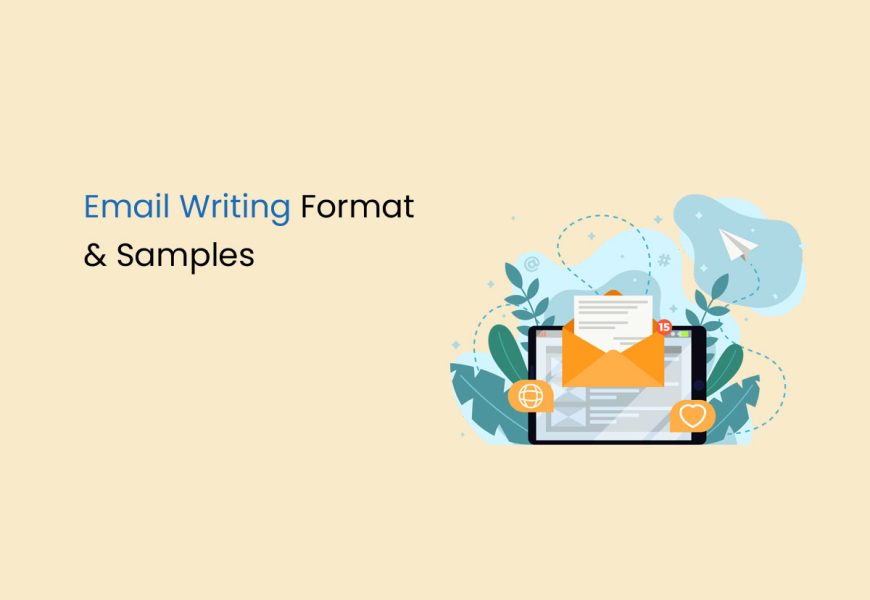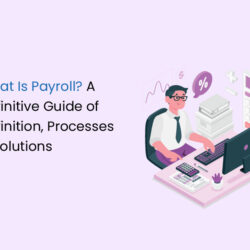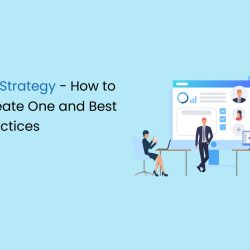When it comes to communication email writing is a widespread method of interaction. Its speed and ability to convey messages make it indispensable, in the world. Therefore mastering the art of email writing holds importance.
In our blog, we will explore the details of effective email communication. We will delve into the steps for composing emails covering both informal formats. With a focus on clarity and brevity, we will discuss how to craft concise messages.
We will also analyze email writing elements and understand the tones and expressions that make it effective. Additionally, we will unravel the complexities of email writing emphasizing the etiquettes and structures crucial for correspondence.
How to Write an Email?
When crafting emails, it is essential to adhere to certain guidelines. Much like formal and informal letters, emails can adopt either a casual or professional tone, depending on the context. The format of the email varies accordingly. Moreover, meticulous attention to spelling and grammar is crucial to convey your message accurately and professionally.
Email Address
It goes without saying that you always need to ensure that you’re putting in the correct mail address, as even the slightest error can put your mail into someone else’s inbox or fail to deliver your email altogether.
Subject
The subject line of an email stands as the initial interaction point with your readers, making it a crucial element of your communication. This single line of text holds the power to captivate your audience effectively. Following the subject line, an email pre-header offers a sneak peek into the email’s content. To enhance the impact of your emails, consider these guidelines for crafting compelling subject lines:
- Conciseness is Key: Keep your email subject short and concise, ideally within 40-60 characters. Brevity ensures clarity and grabs attention instantly.
- Know Your Recipient: Understanding your target audience is fundamental. Prior to drafting your email and subject line, delve into the preferences and interests of your readers. This knowledge enables you to create subject lines that align with their expectations.
- Avoid Spam Language: Steer clear of using words or phrases that commonly trigger spam filters. Crafting subject lines devoid of spam-related terms ensures that your emails reach the intended recipients’ inboxes, increasing the likelihood of them being read.
Salutation
The choice of an appropriate salutation sets the tone for your email and reflects your professionalism. In formal contexts, it is advisable to commence your email with a respectful salutation such as “Dear Sir/Ma’am” or “Respected Sir/Ma’am”. On the other hand, in more informal settings, you can opt for a friendly approach by addressing the recipient with their first or last name following “Dear”.
Please note that the right salutation establishes a polite and considerate tone, demonstrating your respect for the recipient and reinforcing the professionalism of your communication.
Body
it’s essential to gather all the necessary information and facts, including specific dates, names, or figures, before proceeding with your email. Additionally, maintaining a consistent email font size and style enhances readability and professionalism.
When composing your email, adhere to the 7Cs of Communication: be clear, concise, concrete, correct, coherent, complete, and courteous. Clear and precise language, supported by accurate and specific details, ensures your message is easily understood. Coherence and completeness guarantee that your email is logically structured and provides all necessary information.
Furthermore, it’s advisable to maintain a formal tone in your professional communication. Avoid using slang, initialisms, or colloquial language such as “kinda” or “TTYL,” even when corresponding with close colleagues or classmates. Upholding a standard of professionalism in your language and communication style reflects positively on your image and ensures clarity in your message.
Sign Off
The closing of your email holds significant importance, particularly in professional contexts where you engage with prospects, partners, and customers within your network. Maintaining a brief and concise closure is crucial, tailored to the specific context of the email.
Here are some examples of suitable closings for various scenarios:
For Formal Business:
- Regards
- Best wishes
- Sincerely
- Cordially
- With sincere appreciation
- Thank you for the opportunity
For Informal Business:
- Cheers
- Best
Selecting an appropriate closing enhances the professionalism and courtesy of your email, leaving a positive impression on the recipient.
Signature
A signature serves as a personalised block of text at the end of your email, containing contact information and branding details. A well-crafted email signature can significantly impact your readers’ perception, influencing reading and response rates. It serves multiple purposes, including
It creates a positive image of yourself and your company. It also demonstrates professionalism and courtesy towards the recipient. In some cases, it also reinforces brand awareness through consistent branding elements.
Example of an Email Signature:
Shreya Mishra
Sales Manager | IBF Marketing Solutions
Phone: 123-322-1550
Website: yourbusiness@email.com
Email Writing Format
This is a basic email writing format that can be followed by you.
Subject: [Briefly Mention the Purpose of Email]
Dear Sir/Madam,
Body: [Compose your email message here. Be clear, concise, and polite in your communication. Address the main points or concerns, providing necessary details.]
Kind regards,
[Your Full Name]
[Your Position/Title]
[Organisation/School/Institution Name]
[Contact Number]
Sample of Informal Email Writing
If you find yourself struggling to write a concise email, these samples shall help you in the right direction.
Hey [Friend’s Name],
I hope this email finds you in great spirits! It’s been a while since we last caught up, and I wanted to drop you a line and see how you’ve been doing.
Life on my end has been pretty busy but in a good way. Work’s been keeping me occupied, and I’ve been diving into a few new hobbies as well. I’ve recently started painting, and it’s been such a therapeutic experience.
Speaking of hobbies, have you picked up anything interesting lately? I’d love to hear about what’s been keeping you busy and what you’re passionate about these days.
Remember that trip we talked about? I’ve been researching some cool destinations. Let me know your thoughts on where you’d like to go. It would be awesome to plan something together.
Oh, and I can’t forget to tell you about this amazing new café I discovered downtown. Their coffee is out of this world, and they have the cosiest atmosphere. We should definitely check it out together.
Anyway, I don’t want to make this email too long. Let’s catch up properly soon. How about a call this weekend? Let me know if you’re free, and we can schedule a time for both of us.
Take care and talk soon!
Warm regards,
[Your Name]
Email Writing Sample 1: Email For Holiday Trip
Hey [Friend’s Name],
I hope this email finds you well! I am thrilled to share some exciting news with you. Our long-awaited holiday trip is finally in the planning stage, and I couldn’t be more excited about it!
After much thought and research, we’ve decided to head to [Destination]. The place is renowned for its picturesque landscapes, rich culture, and mouthwatering cuisine – everything we look for in a perfect holiday destination.
I wanted to check in with you about your preferences for the trip. Is there anything specific you’d like to explore or any activities you’re particularly interested in? Your input is valuable in making our trip memorable for everyone.
Also, I’m in the process of booking accommodations. If you have any preferences regarding the type of stay you’d like, please let me know, and I’ll make sure to consider that while making reservations.
I’m eagerly looking forward to creating wonderful memories together on this trip. Let’s coordinate our schedules and have a call some time this week to discuss the details further.
If there’s anything specific you’d like to include in our itinerary, feel free to share your thoughts. Can’t wait to embark on this adventure together!
Warmest regards,
[Your Name]
Email Writing Sample 2: Random Email To A Friend
Hey [Friend’s Name],
I hope you’re doing great!
I’ve been swamped since my new job at Company X started, but things are going well. How’s life with [Partner’s Name] and the kids? I hope [Kid’s Name] enjoyed his birthday gift.
Exciting news: [Name] graduated as the class topper last week! She’s gearing up for the entrance exams at XYZ College. Fingers crossed for her!
We really need to catch up. It’s been ages since our families hung out. Let me know when you’re free for dinner at our place.
Take care and talk soon!
Warm regards,
[Your Name]
Email Writing Sample 3: Congratulatory Email
Hey [Friend’s Name],
I just received your invitation for the opening of your new restaurant. Congratulations!
I can’t express how happy and proud I am of you. I know this has been your dream for ages, and seeing it come true is incredible. You’ve worked so hard, and now you’re reaping the rewards.
I’ll definitely be there on the opening night. I can’t wait to celebrate this amazing achievement with you!
Warm regards,
[Your Name]
Formal Email Writing Format
CC: [Email addresses of additional recipients]
BCC: [Email addresses of additional recipients, hidden]
Subject: [Purpose of Email]
Dear Sir,
I hope this email finds you well.
I am writing to extend my greetings and best wishes to you. [Add specific details or introduction here, if applicable, e.g., “I wanted to take a moment to wish you good luck for your future endeavours, Anil.”]
[Continue with the main body of the email.]
Closing:
Yours sincerely,
[Your Full Name]
[Your Position/Title]
[Your Organisation]
[Contact Number]
[Email Address]
Attachments: [List the names of attached PDFs and files, if any]
Sample 1: Farewell Email
Dear Team,
I hope this email finds you in good spirits.
It is with mixed feelings that I announce my departure from [Company Name]. After [number of years] years of working alongside such talented and dedicated individuals, the time has come for me to explore new opportunities and challenges. I wanted to take a moment to express my heartfelt gratitude for the support, camaraderie, and valuable experiences I have had here.
I am incredibly grateful for the friendships I’ve made, the skills I’ve learned, and the memories I’ll carry with me. As I move forward into this new chapter, I will always cherish the time spent here and the lessons I’ve learned from each of you.
I would like to express my sincerest thanks to each one of you for making my time at [Company Name] memorable and rewarding. Please stay in touch. You can reach me at my personal email address: [Your Personal Email].
I wish you all continued success and fulfilment in your roles. I hope our paths cross again in the future.
Warm regards,
[Your Full Name]
[Your Position]
[Company Name]
[Email Address]
[Phone Number]
Sample 2: Email on Seeking Information Regarding Course Details
Dear Sir/Madam,
I hope this email finds you well.
I am writing to inquire about the details of the [Course Name] offered by your institution. I am interested in enrolling for this course and would appreciate it if you could provide me with comprehensive information regarding the curriculum, duration, fees, and any other relevant details. Additionally, if there are any upcoming orientation sessions or open houses, I would like to attend to gain a better understanding of the course structure and the opportunities it offers.
I am particularly interested in [specific aspect of the course, if applicable, e.g., the focus on practical training, industry collaborations, etc.] and would like to know more about how this course can help me achieve my career goals.
I understand that you are likely busy, and I truly appreciate your time and assistance in providing me with the necessary information. If there are any application deadlines or documents required for the application process, kindly let me know, and I will ensure to fulfil the requirements promptly.
Thank you in advance for your attention to this request. I look forward to your response.
Warm regards,
[Your Full Name]
[Your Contact Number]
[Your Email Address]
Sample 3: Email on introducing a new employee to your team
Dear Team,
I am pleased to announce the newest addition to our team, [New Employee’s Name]. [He/She] joins us as [New Employee’s Position] and brings with [him/her] a wealth of experience and enthusiasm that I am sure will greatly benefit our team.
[New Employee’s Name] comes to us from [Previous Company/Institution], where [he/she] was involved in [brief description of their previous role or experience]. [He/She] holds a degree in [Relevant Degree] and has a passion for [mention any specific skills or interests].
Please join me in extending a warm welcome to [New Employee’s Name]. I am confident that [he/she] will quickly become a valuable asset to our team, and I encourage each of you to reach out and introduce yourselves.
[New Employee’s Name], please feel free to reach out if you have any questions or need assistance settling in. We are thrilled to have you on board and look forward to working together to achieve our shared goals.
Best regards,
[Your Full Name]
[Your Position/Title]
[Company Name]
[Your Email Address]
[Your Phone Number]
Sample 4: Email on Official Intimation of Your Resignation
Dear [Supervisor’s Name],
I hope this email finds you well. It is with a mix of emotions that I write to officially inform you of my decision to resign from my position at [Company Name]. After careful consideration, I have decided to take on a new opportunity that aligns with my career goals and aspirations.
My last working day at [Company Name] will be 2024. I assure you that I will do my best to ensure a smooth transition during this period. I am more than willing to assist in training a replacement or pass on my duties to a designated colleague.
I want to express my deepest gratitude for the opportunities, support, and experiences that I have gained during my tenure at [Company Name]. I have enjoyed working here and have learned a great deal from you and my colleagues. I am thankful for the guidance and encouragement I have received.
Please let me know if there are specific tasks or responsibilities you would like me to prioritize during my notice period. I am open to discussions regarding the transition process and will ensure that all pending work is completed before my departure.
Thank you once again for the opportunity to be a part of [Company Name]. I look forward to staying in touch and hope our paths cross again.
Warm regards,
[Your Full Name]
[Your Position/Title]
[Company Name]
[Your Email Address]
[Your Phone Number]
Sample 5: Email informing your employees about the change in work timings
Dear Team,
I hope this message finds you in good health. I am writing to inform you about an upcoming change in our work timings, effective from 2024.
Starting 2024, our new office hours will be as follows:
Monday to Thursday: 9:00 AM to 6:00 PM
Friday: 9:00 AM to 3:00 PM
We have made this adjustment to better align our working hours with the needs of our clients and to enhance overall efficiency within the team. We believe that this change will improve our productivity and help us serve our clients more effectively.
Please ensure that you adjust your schedules accordingly. If you have any concerns or questions regarding this change, feel free to reach out to your respective supervisors or the HR department.
We appreciate your understanding and cooperation during this transition period. Thank you for your dedication and hard work. We believe that these changes will benefit all of us in the long run.
Best regards,
[Your Full Name]
[Your Position/Title]
[Company Name]
[Your Email Address]
[Your Phone Number]
Sample 6: Email of Marriage Leave Application
Dear [Supervisor’s Name],
I hope this email finds you well. I am writing to formally request a leave of absence from work due to my upcoming marriage ceremony. I am planning to get married on 2024 and the associated ceremonies and arrangements require my presence and involvement, necessitating my absence from work for [number of days] starting from [start date] to [end date].
I understand the importance of my responsibilities at work and assure you that I will complete all pending tasks and delegate my duties to a colleague, [Colleague’s Name], during my absence to ensure a smooth workflow. I will make sure that all necessary handovers are done before my departure.
I am more than willing to assist in any way possible to minimize the impact of my absence. I will be reachable via email and phone in case of any urgent matters that require my attention.
I have attached the wedding invitation for your reference and for the HR department’s records.
I am grateful for your understanding and support during this significant moment in my life. I assure you that I will resume work promptly on [return date] and will make every effort to ensure a seamless transition back into my responsibilities.
Thank you for considering my request. Please let me know if you need any additional information.
Warm regards,
[Your Full Name]
[Your Employee ID]
[Your Department]
[Your Email Address]
[Your Phone Number]
Sample 7: Email of Annual School Sports Announcement
Dear Students,
I am thrilled to announce that our school’s Annual Sports Day is just around the corner! This year, the event will be held on 2024 at [venue]. The sports day promises a day filled with exciting competitions, team spirit, and fun activities.
Event Details:
- Date: [Date]
- Venue: [Venue]
- Time: [Time]
We encourage all students to participate actively and showcase their sportsmanship. Please stay tuned for more details regarding the specific sports events and how to register. Let’s make this sports day memorable and full of energy!
Warm regards,
[Your Full Name]
[Your Grade/Class]
[School Name]
Sample 8: Email for Science Project
Dear [Classmates’ Names],
I hope this email finds you well. I am reaching out to propose a collaboration on our upcoming science project. I believe that by pooling our ideas and resources, we can create something truly impressive and innovative.
Project Topic: [Briefly describe the project topic and objectives]
Roles and Responsibilities:
- Research: [Assign specific research tasks to team members]
- Experimentation: [Outline experimental procedures]
- Data Analysis: [Detail how data will be collected and analyzed]
- Presentation: [Discuss how the project findings will be presented]
Let’s schedule a meeting this [day] after school to brainstorm ideas and divide tasks. Please confirm your availability, and feel free to share any initial thoughts you might have about the project.
I am looking forward to working together and creating a standout project!
Best regards,
[Your Full Name]
[Your Grade/Class]
[School Name]
Avoiding Common Email Writing Mistakes
Effective communication fosters understanding and efficiency. Following these guidelines will ensure that your emails are professional yet easily comprehensible, promoting seamless interactions in the professional sphere.
- Subject Line Precision: Your subject line should concisely reflect the email’s content. Avoid vague or generic subjects like “Hey,” and instead, be specific. For instance, “Continuing Our LinkedIn Conversation” provides clarity and context.
- Concise and Focused Content: Keep your emails clear, brief, and focused on one topic. Lengthy, text-heavy emails can overwhelm recipients. Address one subject per email, allowing for quick comprehension and response.
- Avoid Ambiguity: Clear communication is key. Ambiguous language can lead to misunderstandings. Be precise and straightforward in your messaging, ensuring there’s no room for misinterpretation.
- Clarify Attachments: When sending attachments, provide a brief explanation. Use relevant keywords, and ensure recipients understand the content they’re about to open. This aids in easy retrieval and comprehension later.
- Avoid Jargon: While industry jargon might seem commonplace, not everyone is familiar with it. Opt for plain language to ensure your message is universally understood. Avoiding jargon prevents unnecessary explanations and saves time.
- Proofreading: Before hitting send, take a moment to proofread your email. Correct any spelling or grammar errors. This applies particularly to emails sent from mobile devices, where autocorrect mishaps can occur.
Politeness and Etiquette in Email Writing
- Be Polite: Politeness in emails is not just a formality; it’s a cornerstone of professional communication. Address your recipient with respect by using proper salutations like “Dear [Recipient’s Name],” and incorporate phrases like “please” and “thank you” where applicable. These courtesies show your consideration and create a positive atmosphere, enhancing the overall tone of your email.
- Feedback and Criticism: When dealing with negative feedback or criticism, it’s crucial to maintain composure and professionalism. Begin your response by acknowledging the concern empathetically. Avoid defensive language and focus on addressing the issue constructively. Express gratitude for the feedback and assure the sender that their concerns are valued. End your response with a positive note, reinforcing your commitment to resolving the matter. This approach not only defuses tension but also demonstrates your professionalism and ability to handle challenging situations gracefully.
- Signature Block: Incorporating a signature block is essential to establish credibility and authenticity. Include your full name, job title, company, and contact number at the end of your email. This not only provides vital information about you but also reassures the recipient of the legitimacy of your communication.
Email Writing Formatting Tips
Presentation holds significant weight in almost everything we do, emails are no exception to that. Here are some key pointers to help you master the art of email formatting:
Using Fonts, Colors, and Formatting Tools
The choice of fonts and colours in your emails can significantly impact how your message is received. Opt for standard, easily readable fonts like Arial or Times New Roman. Dark text on a light background ensures clarity. Judiciously use bold, italics, and bullet points when it comes to emphasis. These formatting tools draw attention to crucial information without overwhelming your recipients. Remember, simplicity and consistency are paramount for a professional appearance.
Attachments and Links
Attachments play a vital role in supplementing information. Always indicate the presence of attachments in your email, briefly describing their content. Additionally, use descriptive anchor text instead of long URLs when incorporating links. This looks neater while clarifying the link’s purpose to your readers. Always double-check when it comes to hyperlinks, ensuring they lead to reliable sources. Verify links before sending to avoid potential inaccuracies or broken connections.
FAQs On Email Writing
How to write an email?
An email needs to include these essential details:
- Subject Line: Be concise and clear. Summarise the purpose of your email.
- Greeting: Use a polite salutation. If you know the recipient's name, use it (e.g., "Dear Mr. Smith").
- Body: Be concise and to the point. Use short paragraphs and bullet points for clarity.
- Closing: Use a courteous closing (e.g., "Best regards," "Sincerely,") followed by your full name.
- Signature: Include your name, job title, company, and contact information.
How to write an email for a job application?
If you are writing an email to apply for a job, make sure it has these elements and details:
- Subject Line: Include the job title you're applying for.
- Greeting: Address the recipient formally (e.g., "Dear Hiring Manager,").
- Introduction: Mention the position you're applying for and how you found out about the job.
- Body: Highlight your qualifications, skills, and enthusiasm for the position. Be specific and relate your skills to the job requirements.
- Closing: Express appreciation for considering your application. Politely request an interview.
- Attachment: Attach your resume and any other relevant documents.
- Signature: Include a professional signature with your full name and contact information.
What to write in an email when sending a resume?
Here’s what you need to include in your mail while sending your resume:
- Subject Line: Mention the purpose (e.g., "Resume for Marketing Position").
- Greeting: Use a formal salutation (e.g., "Dear Hiring Manager,").
- Body: Briefly introduce yourself and explain the purpose of the email. Mention that your resume and cover letter are attached.
- Closing: Express appreciation for the recipient's time and consideration.
- Attachment: Attach your resume and cover letter (if applicable).
- Signature: Provide your full name, phone number, and LinkedIn profile (if available).
How to write a resignation email?
If you are writing a resignation email, here is all that you need to put in it:
- Subject Line: Be clear (e.g., "Resignation - Your Name").
- Greeting: Address your immediate supervisor or HR manager.
- Statement of Resignation: Clearly state that you are resigning from your position and provide your last working day.
- Gratitude: Express gratitude for the opportunities and experiences gained while working in the company.
- Offer Assistance: Offer to assist with the transition, if possible.
- Closing: Offer well wishes for the future and maintain a professional tone.
- Signature: Include your full name and contact information.
How to write a formal email?
Here is a format for writing a formal email:
- Subject Line: Be specific and concise about the email's purpose.
- Greeting: Use a formal salutation appropriate for the recipient (e.g., "Dear Dr. Johnson,").
- Body: Be clear, polite, and concise. State your purpose and provide necessary details.
- Closing: Use a formal closing (e.g., "Yours sincerely," "Kind regards,") followed by your full name.
- Signature: Include your full name, job title, company, and contact information.
Remember, it's essential to proofread your emails for errors and ensure they convey the intended message professionally and clearly.





















